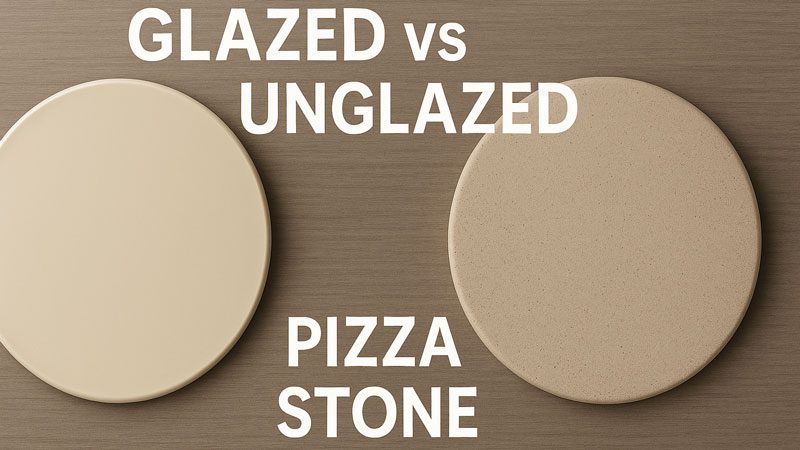Pizza stones are popular tools for baking pizza at home. They help to create a crispy crust, much like a pizza oven. But, there are two main types of pizza stones: glazed and unglazed. This article will help you understand the differences between them. By the end, you will know which type is better for your needs.

What is a Pizza Stone?
A pizza stone is a flat piece of stone or ceramic. It is placed in the oven to bake pizza. The stone absorbs heat and cooks the pizza evenly. This helps to create a crispy crust. It can also be used for baking bread, cookies, and other foods.
Glazed Vs Unglazed Pizza Stone
Glazed Pizza Stone
A glazed pizza stone has a smooth, shiny surface. The glaze is a thin layer of glass. It is applied to the stone and then fired in a kiln. This creates a non-stick surface. It also makes the stone easier to clean.
Advantages Of Glazed Pizza Stone
- Easy to Clean: The smooth surface makes cleaning simple. Food and grease do not stick to the glaze. You can wipe it with a damp cloth.
- Non-Stick Surface: The glaze prevents food from sticking. This makes it easier to remove the pizza. It also means you do not need to use as much flour or cornmeal.
- Less Staining: The glaze helps to prevent stains. This keeps the stone looking new.
Disadvantages Of Glazed Pizza Stone
- Less Absorbent: The glaze makes the stone less absorbent. This means it may not remove as much moisture from the dough. The crust may not be as crispy.
- Potential for Cracking: The glaze can crack if exposed to sudden temperature changes. This can happen if you place a cold stone in a hot oven.
Unglazed Pizza Stone
An unglazed pizza stone has a rough, porous surface. It is made from natural materials like clay or cordierite. The stone is not coated with any glaze or finish. This makes it more absorbent.
Advantages Of Unglazed Pizza Stone
- Crispier Crust: The porous surface absorbs moisture from the dough. This helps to create a crispier crust.
- More Durable: Unglazed stones are less likely to crack. They can withstand sudden temperature changes.
- Natural Flavor: The natural materials can add a unique flavor to the pizza. Some people believe this improves the taste.
Disadvantages Of Unglazed Pizza Stone
- Harder to Clean: The rough surface can trap food and grease. This makes it harder to clean. You may need to scrub it with a brush.
- Staining: The porous surface can absorb stains. Over time, the stone may become discolored.
- Requires Seasoning: Some unglazed stones need to be seasoned before use. This involves coating the stone with oil and baking it. This helps to create a non-stick surface.
Comparison Table
| Feature | Glazed Pizza Stone | Unglazed Pizza Stone |
|---|---|---|
| Surface | Smooth and shiny | Rough and porous |
| Cleaning | Easy to clean | Harder to clean |
| Non-Stick | Non-stick surface | May require seasoning |
| Durability | Can crack with sudden temperature changes | More durable |
| Crust | Less crispy | Crispier |
| Staining | Less staining | More staining |
How to Choose the Right Pizza Stone
Choosing the right pizza stone depends on your needs. Here are some factors to consider:
1. Cleaning
If you want easy cleaning, choose a glazed stone. The smooth surface makes it simple to wipe clean.
2. Crust
If you prefer a crispy crust, choose an unglazed stone. The porous surface absorbs moisture, making the crust crispier.
3. Durability
If you are worried about cracking, choose an unglazed stone. It is more durable and can handle sudden temperature changes.
4. Staining
If you want to avoid stains, choose a glazed stone. The glaze helps to prevent stains and keeps the stone looking new.
Frequently Asked Questions
What Is The Difference Between Glazed And Unglazed Pizza Stones?
Glazed pizza stones have a smooth surface. Unglazed stones are porous. Glazed stones are easier to clean.
Which Is Better For Crispy Pizza, Glazed Or Unglazed Stone?
Unglazed stones absorb moisture better. This helps to make a crispier crust. Glazed stones may not absorb moisture as well.
Can You Use Soap To Clean A Glazed Pizza Stone?
Yes, you can use soap on glazed stones. They are non-porous and won’t absorb soap. Unglazed stones should be cleaned without soap.
Conclusion
Both glazed and unglazed pizza stones have their pros and cons. Glazed stones are easier to clean and less likely to stain. Unglazed stones create a crispier crust and are more durable. Consider your needs and preferences when choosing a pizza stone. Happy baking!
